Synthesis, Biophysical Interaction of DNA/BSA, Equilibrium and Stopped-Flow Kinetic Studies, and Biological Evaluation of bis(2-Picolyl)amine-Based Nickel(II) Complex
Abstract
:1. Introduction
2. Experimental
2.1. Materials and General Methods
2.2. Synthesis of the NiBPA
2.3. DNA Interaction Studies
2.4. Protein Binding Studies
2.5. Protein and ctDNA Kinetic Investigation Studies
2.6. Cell Viability Assay
3. Results and Discussion
3.1. Synthesis and Structural Characterization
3.2. Protein Binding Studies
3.3. ct-DNA Binding Studies
3.4. Mechanistic Investigation of Protein/DNA Binding
3.5. Cytotoxic Activity
3.6. Antibacterial Activity
4. Conclusions
Author Contributions
Funding
Institutional Review Board Statement
Data Availability Statement
Conflicts of Interest
References
- Kramer, R. Dimeric versus polymeric coordination in copper(II) cationic complexes with bis(chelating) oxime and amide ligands Coord. Chem. Rev. 1999, 182, 243. [Google Scholar]
- Usman, M.; Zaki, M.; Khan, R.A.; Alsalm, A.; Ahmad, M.; Tabassum, S. Coumarin centered copper(ii) complex with appended-imidazole as cancer chemotherapeutic agents against lung cancer: Molecular insight via DFT-based vibrational analysis. RSC Adv. 2017, 7, 36056. [Google Scholar] [CrossRef] [Green Version]
- Cowan, J.A. Metal Activation of Enzymes in Nucleic Acid Biochemistry. Chem. Rev. 1998, 98, 1067. [Google Scholar] [CrossRef] [PubMed]
- Sreedhara, A.; Cowan, J.A. Catalytic hydrolysis of DNA by metal ions and complexes. J. Biol. Inorg. Chem. 2001, 6, 337. [Google Scholar] [CrossRef] [PubMed]
- Bales, B.C.; Kodama, T.; Weledji, Y.N.; Pitie, M.; Meunier, B.; Greenberg, M.M. Water-soluble CuII and MnII bis-phenanthroline octanedioate complexes with unprecedented nano and picomolar in vitro complexes with unprecedented nano and picomolar in vitro cytotoxicity as promising leads for chemotherapeutic drug cytotoxicity as promising leads for chemotherapeutic drug development. Nucleic Acids Res. 2005, 33, 5371. [Google Scholar]
- Fernandes, G.L.; Parrilha, J.A.; Lessa, L.J.M.; Santiago, M.M.; Kanashiro, F.; Boniolo, F.S.; Bortoluzzi, A.J.; Vugman, N.V.; Herbst, M.H.; Horn, A. Catalase vs. Peroxidase Activity of a Manganese (II) Compound: Identification of a Mn(III)-(μ-O)2-Mn(IV) Reaction Intermediate by Electrospray Ionization Mass Spectrometry and Electron Paramagnetic Resonance Spectroscopy. Inorg. Chim. Acta 2006, 359, 3167. [Google Scholar] [CrossRef]
- Marzano, M.; Pellei, F.; Tisato, F.; Santini, C. Copper complexes as anticancer agents. Anticancer. Agents Med. Chem. 2009, 9, 185. [Google Scholar] [CrossRef]
- Mobley, H.L.; Hausinger, R.P. Microbial ureases: Significance, regulation, and molecular characterization. Microbiol. Rev. 1989, 53, 85. [Google Scholar] [CrossRef]
- Lee, S.Y.; Hille, A.; Frias, C.; Kater, B.; Bonitzki, B.; Wölfl, S.; Scheffler, H.; Prokop, A.; Gust, R. [Fe(III)(salophene)Cl], a potent iron salophene complex overcomes multiple drug resistance in lymphoma and leukemia cells. J. Med. Chem. 2010, 53, 6064. [Google Scholar] [CrossRef]
- Pradeepa, S.M.; Naik, H.S.B.; Kumar, B.V.; Priyadarsini, K.I. Cobalt(II), Nickel(II) and Copper(II) complexes of a tetradentate Schiff base as photosensitizers: Quantum yield of 1O2 generation and its promising role in the antitumor activity. Spectrochim. Acta 2013, 101, 132. [Google Scholar] [CrossRef]
- Sathisha, M.P.; Shetti, U.N.; Revankar, V.K.; Pai, K.S.R. Synthesis and antitumor studies on novel Co(II), Ni(II) and Cu(II) metal complexes of bis(3-acetylcoumarin)thiocarbohydrazone. Eur. J. Med. Chem. 2008, 43, 2338. [Google Scholar] [CrossRef]
- Foye, W.O. Cancer Chemotherapeutic Agents; American Chemical Society: Washington, DC, USA, 1995; p. 369. [Google Scholar]
- Yin, H.D.; Liu, H.; Hong, M. Synthesis, structural characterization and DNA-binding properties of organotin(IV) complexes based on Schiff base ligands derived from 2-hydroxy-1-naphthaldy and 3- or 4-aminobenzoic acid. J. Organomet. Chem. 2012, 713, 11. [Google Scholar] [CrossRef]
- Sathyadevi, P.; Krishnamoorthy, P.; Butorac, R.R.; Cowley, A.H.; Bhuvanesh, N.S.P.; Dharmaraj, N. Potentially cytotoxic new copper(II) hydrazone complexes: Synthesis, crystal structure and biological properties. Dalton Trans. 2011, 40, 9690. [Google Scholar] [CrossRef] [PubMed] [Green Version]
- Jin, Y.; Lewis, M.A.; Gokhale, N.H.; Long, E.C.; Cowan, J.A. DNA cleavage behavior of a new p-xylyl spaced bis-Cu(BPA)Cl2 complex: The steric effect of a bulky p-xylyl-derived spacer. J. Am. Chem. Soc. 2007, 129, 8353. [Google Scholar] [CrossRef]
- Bisceglie, F.; Baldini, M.; Belicchi-Ferrari, M.; Buluggiu, E.; Careri, M.; Pelosi, G.; Pinelli, S.; Tarasconi, P. Metal complexes of retinoid derivatives with antiproliferative activity: Synthesis, characterization, and DNA interaction studies. Eur. J. Med. Chem. 2007, 42, 627. [Google Scholar] [CrossRef]
- Barone, G.; Cambino, N.; Ruggirello, A.; Silvestri, A.; Terenzi, A.; Liveri, V.T. Spectroscopic study of the interaction of Ni(II)-5-triethyl ammonium methyl salicylidene ortho-phenylendiiminate. Chem. -A Eur. J. 2009, 88, 3233. [Google Scholar]
- Kirin, S.I.; Happel, C.M.; Hrubanova, S.; Weyhermüller, T.; Klein, C.; Metzler-Nolte, N. Synthesis, structure and comparison of the DNA cleavage ability of metal complexes M(II)L with the N-(2-ethoxyethanol-bis(2-picolyl)amine ligand L (M = Co, Ni, Cu and Zn). Dalton Trans. 2004, 1201. [Google Scholar] [CrossRef]
- Stamler, J.S.; Loscalzo, D.J.S.J. Nitric oxide directly activates calcium-dependent potassium channels in vascular smooth muscle. Science 1992, 258, 1898. [Google Scholar] [CrossRef]
- Shrivastava, H.Y.; Kanthimathi, M.; Niar, B.U. DNA Cleavage by a Chromium(III) Complex. Biochem. Biophys. Res. Commun. 1999, 265, 311. [Google Scholar] [CrossRef]
- Raja, D.S.; Bhuvanesh, N.S.P.; Natarajan, K. Cubane core/1D polynuclear copper(II) complexes: Structure, protein/DNA binding, and magnetic properties. Inorg. Chem. 2011, 50, 12852. [Google Scholar]
- Wende, C.; Lüdtke, C.; Kulak, N. Copper Complexes of N-Donor Ligands as Artificial Nucleases. Eur. J. Inorg. Chem. 2014, 2014, 2597. [Google Scholar] [CrossRef]
- Ma, D.-L.; He, H.-Z.; Leung, K.-H.; Chan, D.S.-H.; Leung, C.-H. Bioactive Luminescent Transition-Metal Complexes for Biomedical Applications. Angew. Chem. Int. Ed. 2013, 52, 7666. [Google Scholar] [CrossRef] [PubMed]
- Gill, M.R.; Thomas, J.A. Ruthenium(ii) polypyridyl complexes and DNA—from structural probes to cellular imaging and therapeutics. Chem. Soc. Rev. 2012, 41, 3179. [Google Scholar] [CrossRef] [PubMed]
- Salassa, L. Polypyridyl Metal Complexes with Biological Activity. Eur. J. Inorg. Chem. 2011, 2011, 4931. [Google Scholar] [CrossRef]
- Schatzschneider, U. Photoactivated Biological Activity of Transition-Metal Complexes. Eur. J. Inorg. Chem. 2010, 2010, 1451. [Google Scholar] [CrossRef]
- Hancock, R.D. The pyridyl group in ligand design for selective metal ion complexation and sensing. Chem. Soc. Rev. 2013, 42, 1500. [Google Scholar] [CrossRef]
- Vos, J.G.; Kelly, J.M. Ruthenium polypyridyl chemistry; from basic research to applications and back again. Dalton Trans 2006, 41, 4869. [Google Scholar] [CrossRef]
- Alstrum-Acevedo, J.H.; Brennaman, M.K.; Meyer, T.J. Chemical Approaches to Artificial Photosynthesis. 2. Inorg. Chem. 2005, 44, 6802. [Google Scholar] [CrossRef] [Green Version]
- Mortezaei, S.; Caterineu, N.; Canary, J.W. A Redox-Reconfigurable, Ambidextrous Asymmetric Catalyst. J. Am. Chem. Soc. 2012, 134, 8504. [Google Scholar] [CrossRef]
- Sundaravel, K.; Suresh, E.; Saminathan, K.; Palaniandavar, M. Iron(III) complexes of N2O and N3O donor ligands as functional models for catechol dioxygenase enzymes: Ether oxygen coordination tunes the regioselectivity and reactivity. Dalton Trans. 2011, 40, 8092. [Google Scholar] [CrossRef]
- Frezza, M.; Hindo, S.S.; Tomco, D.; Allard, M.M.; Cui, Q.C.; Heeg, M.J.; Chen, D.; Dou, Q.P.; Verani, N.C. Comparative Activities of Nickel(II) and Zinc(II) Complexes of Asymmetric [NN′O] Ligands as 26S Proteasome Inhibitors. Inorg. Chem. 2009, 48, 5928. [Google Scholar] [CrossRef] [Green Version]
- Carney, M.J.; Robertson, N.J.; Halfen, J.A.; Zakharov, L.N.; Rheingold, A.L. Octahedral Chromium(III) Complexes Supported by Bis(2-pyridylmethyl)amines: Ligand Influence on Coordination Geometry and Ethylene Polymerization Activity. Organometallics 2004, 23, 6184. [Google Scholar] [CrossRef]
- Andres, P.R.; Schubert, U.S. New Functional Polymers and Materials Based on 2,2:6,2-Terpyridine Metal Complexes. Adv. Mater. 2004, 16, 1043. [Google Scholar] [CrossRef]
- Ojida, A.; Mito-oka, Y.; Sada, K.; Hamachi, I. Molecular Recognition and Fluorescence Sensing of Monophosphorylated Peptides in Aqueous Solution by Bis(zinc(II)−dipicolylamine)-Based Artificial Receptors. J. Am. Chem. Soc. 2004, 126, 2454. [Google Scholar] [CrossRef]
- Goetzke, L.; Gloe, K.; Jolliffe, K.A.; Lindoy, L.F.; Heine, A.; Doert, T.; Joeger, A.; Gloe, K. Nickel(II) and zinc(II) complexes of N-substituted di(2-picolyl)amine derivatives: Synthetic and structural studies. Polyhedron 2011, 30, 708–714. [Google Scholar] [CrossRef]
- Nagataki, T.; Ishii, K.; Tachi, Y.; Itoh, S. Ligand effects on NiII-catalysed alkane-hydroxylation with m-CPBA. Dalton Trans. 2007, 1120. [Google Scholar] [CrossRef]
- Wikstrom, J.P.; Nazarenko, A.Y.; Reiff, W.M.; Rybak-Akomova, E.V. Synthesis and characterization of tetrakis(μ-hydroxo)tetrakis(2,2′-dipicolylamine)tetranickel perchlorate, a nickel-hydroxy cubane complex. Inorg. Chim. Acta 2007, 360, 3733. [Google Scholar] [CrossRef]
- Sarker, S.; Mondal, A.; el Fallah, M.S.; Ribas, J.; Stoeckli-Evans, H.; Rajak, K.K. Synthesis, structure and magnetic properties of two end-on double azido bridged nickel(II) dinuclear entities incorporating N,N,N-coordinating tridentate reduced Schiff base ligands. Polyhedron 2006, 25, 25. [Google Scholar] [CrossRef] [Green Version]
- Škalamera, Đ.; Sanders, E.; Vianello, R.; Maršavelski, A.; Pevec, A.; Turel, I.; Kirin, S.I. Synthesis and characterization of ML and ML2 metal complexes with amino acid substituted bis(2-picolyl)amine ligands. Dalton Trans. 2016, 45, 2845. [Google Scholar] [CrossRef]
- Esposito, B.P.; Najjar, R. DNA/Protein binding, antioxidative, antimicrobial studies of metal complexes with anthranilic acid Schiff base. Coord. Chem. Rev. 2002, 232, 137. [Google Scholar]
- Shaban, N.Z.; Yehia, S.A.; Shoueir, K.R.; Saleh, S.R.; Awad, D.; Shaban, S.Y. Design, DNA binding, and kinetic studies, antibacterial and cytotoxic activities of stable dithiophenolato titanium(IV)-chitosan Nanocomposite. J. Mol. Liq. 2019, 287, 111002. [Google Scholar] [CrossRef]
- Shaban, N.Z.; Aboelsaad, A.M.; Shoueir, K.R.; Abdulmalek, S.A.; Awad, D.; Shaban, S.Y. Chitosan-based dithiophenolato nanoparticles: Preparation, mechanistic information of DNA binding, antibacterial and cytotoxic activities. J. Mol. Liq. 2020, 318, 114252. [Google Scholar] [CrossRef]
- Elshami, F.I.; Ramadan, A.; Ibrahim, M.M.; Elmehasseb, I.M.; Al-Juaid, S.; Shaban, S.Y. Metformin Containing Nickel (II) Complexes: Synthesis, Structural Characterization, Binding and Kinetic Interactions with BSA, Antibacterial and in-vitro Cytotoxicity Studies. Appl. Organometal. Chem. 2019, 34, 5437. [Google Scholar] [CrossRef]
- Shereef, H.A.; Shaban, S.Y.; Moemen, Y.S.; El-Khouly, M.E.; El-Nahas, A.M. Biophysicochemical studies of a ruthenium (II) nitrosyl thioether-thiolate complex binding to BSA: Mechanistic information, molecular docking, and relationship to antibacterial and cytotoxic activities. Appl. Organomet. Chem. 2022, 34, e6583. [Google Scholar] [CrossRef]
- Ibrahim, M.M.; Ramadan, A.M.; Mersal, G.A.M.; El-Shazly, S.A. Synthesis, superoxide dismutase, nuclease, and anticancer activities of copper(II) complexes incorporating bis(2-picolyl)amine with different counter anions. J. Mol. Struct. 2011, 998, 1–10. [Google Scholar] [CrossRef]
- Mosmann, T. Rapid colorimetric assay for cellular growth and survival: Application to proliferation cytotoxicity assays. J. Immunol. Methods 1983, 65, 55–63. [Google Scholar] [CrossRef]
- Liu, W.; Migdisov, A.; Williams-Jones, A. The stability of aqueous nickel(II) chloride complexes in hydrothermal solutions: Results of UV-Visible spectroscopic experiments. Geochim. Cosmochim. Acta 2012, 94, 276–290. [Google Scholar] [CrossRef]
- Ramachandran, E.; Raja, D.S.; Bhuvanesh, N.S.P.; Natarajan, K. Self-assembled Cu(ii) and Ni(ii) metallamacrocycles formed from 3,3,3′,3′-tetrabenzyl-1,1′-aroylbis(thiourea) ligands: DNA and protein binding studies, and cytotoxicity of trinuclear complexes. Dalton Trans. 2012, 41, 13308. [Google Scholar] [CrossRef]
- Raja, D.S.; Paramaguru, G.; Bhuvanesh, N.S.P.; Reibenspies, J.H.; Renganathan, R.; Natarajan, K. Effect of terminal N-substitution in oxo-1,2-dihydroquinoline-3-carbaldehyde thiosemicar-benzones on the mode of coordination structure.interaction of protein, radical scavenging and cytotoxic activity of copper (II) complexes. Dalton Trans. 2011, 40, 4548. [Google Scholar] [CrossRef]
- Raja, D.S.; Bhuvanesh, N.S.P.; Natarajan, K. Synthesis, Characterization and Biological Evaluation of Fe(III) and Cu(II) Complexes with 2,4-Dinitrophenyl hydrazine and Thiocyanate Ions. Eur. J. Med. Chem. 2011, 46, 4584. [Google Scholar]
- Karami, K.; Parsianrad, F.; Alinaghi, M.; Amirghofran, Z. In vitro cytotoxicity studies of palladacyclic complexes containing the symmetric diphosphine bridging ligand: Studies of their interactions with DNA and BSA. J. Inorg. Chim. Acta 2017, 467, 46. [Google Scholar] [CrossRef]
- Gok, E.; Ozturk, C.; Akbay, N. Interaction of oxovanadium(IV)–salphen complexes with bovine serum albumin and their cytotoxicity against cancer. J. Fluoresc. 2008, 18, 781. [Google Scholar]
- Papadopoulou, A.; Green, R.J.; Frazier, R.A. Interaction of flavonoids with bovine serum albumin: A fluorescence quenching study. J. Agric. Food Chem. 2005, 53, 158. [Google Scholar] [CrossRef]
- Williams, M.; Daviter, T. Protein-Ligand Interactions. Biophys. Physicobiol. 2016, 13, 85. [Google Scholar]
- Chung, Y.-C.; Su, Y.P.; Chen, C.-C.; Jia, G.; Wang, H.L.; Wu, J.G.; Lin, J.G. Relationship between antibacterial activity of chitosan and surface characteristics of cell wall. Acta Pharmacol. Sin. 2004, 25, 932. [Google Scholar]
- Xue, Z.-X.; Yang, G.-P.; Zhang, Z.-P.; He, B.-L. Application of chitosan microspheres as carriers of LH-RH analogue TX46 React. Funct. Polym. 2006, 66, 893. [Google Scholar] [CrossRef]
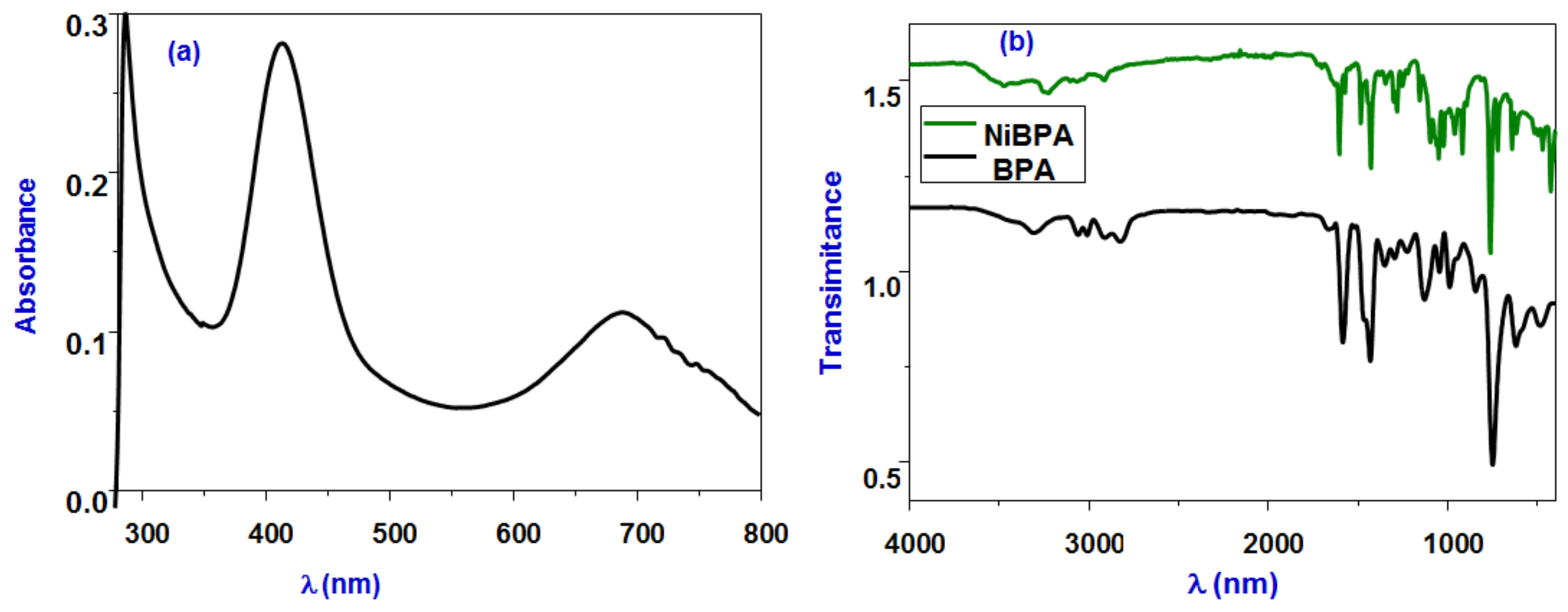
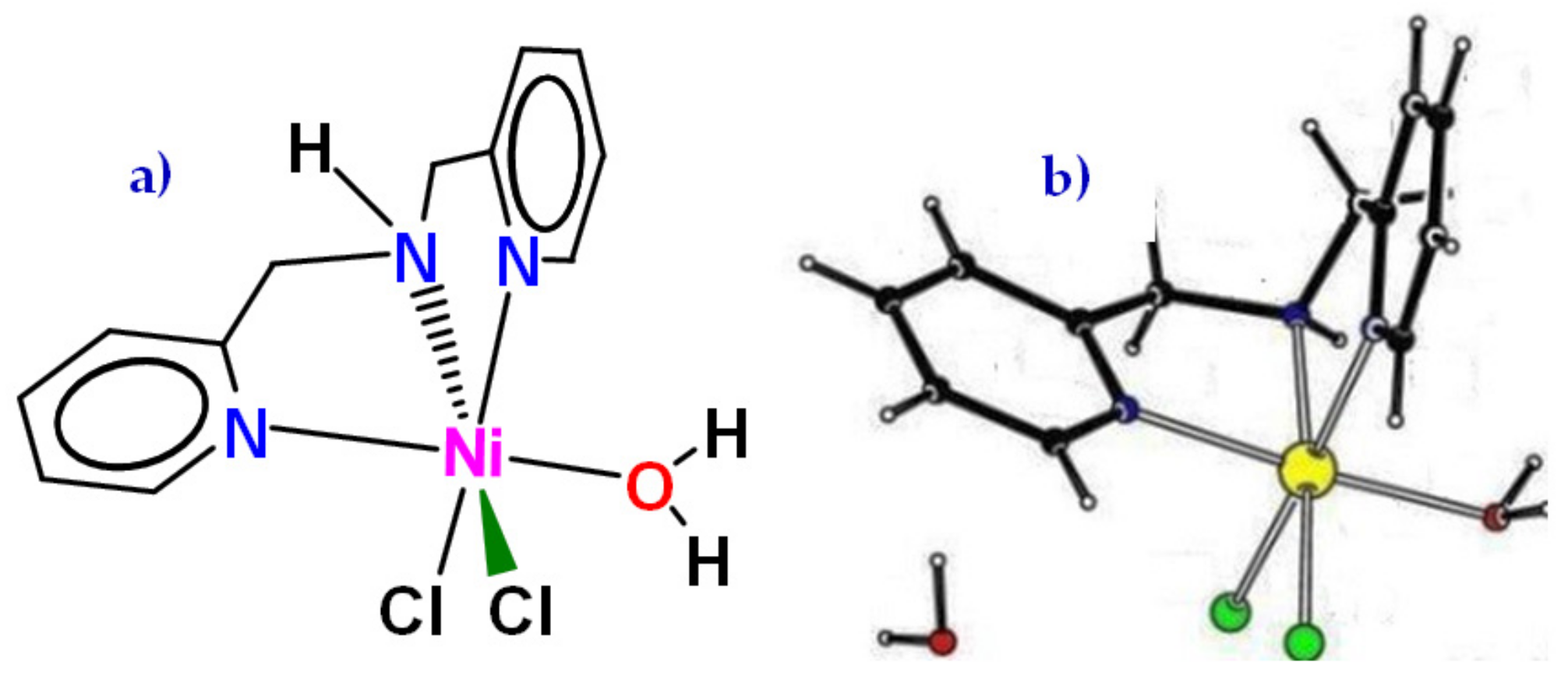

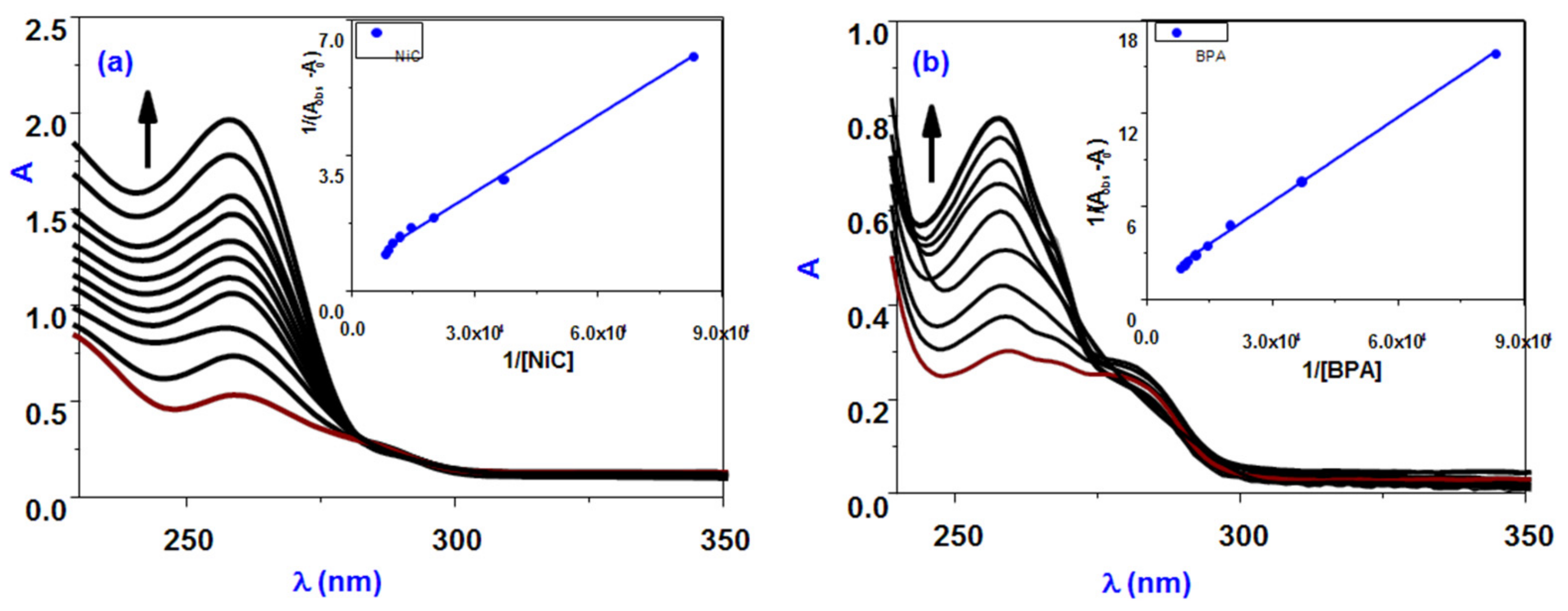

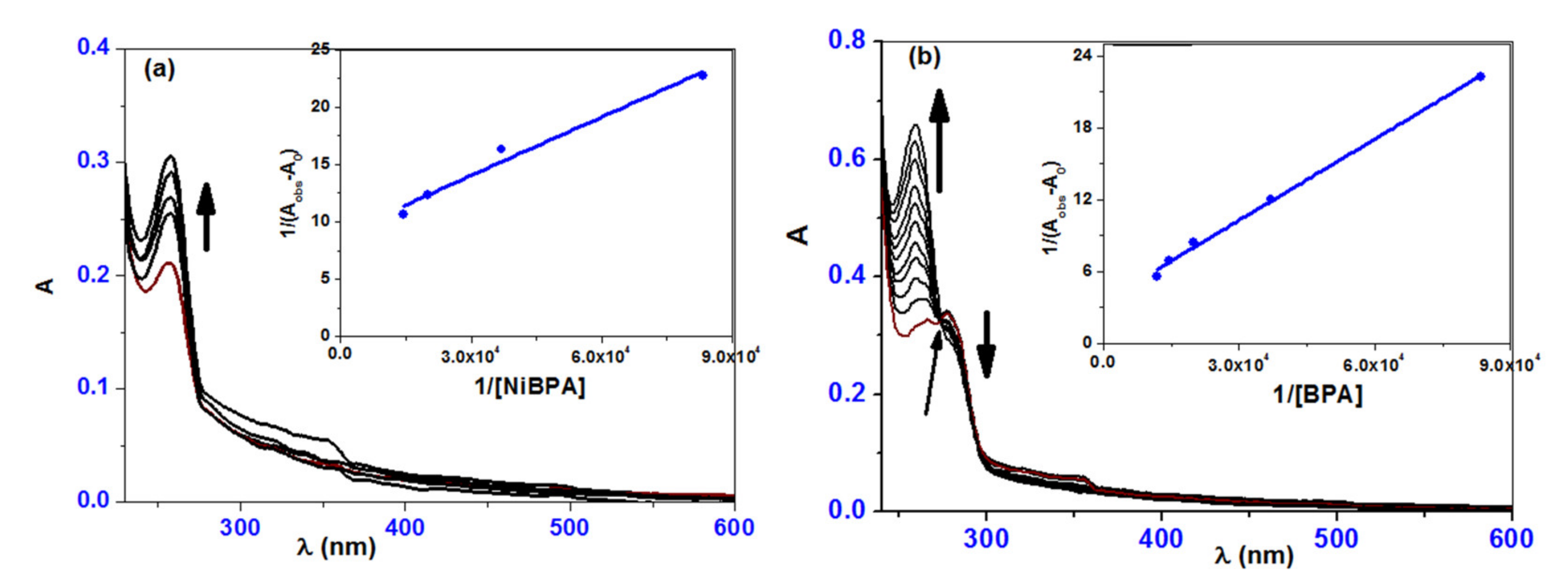
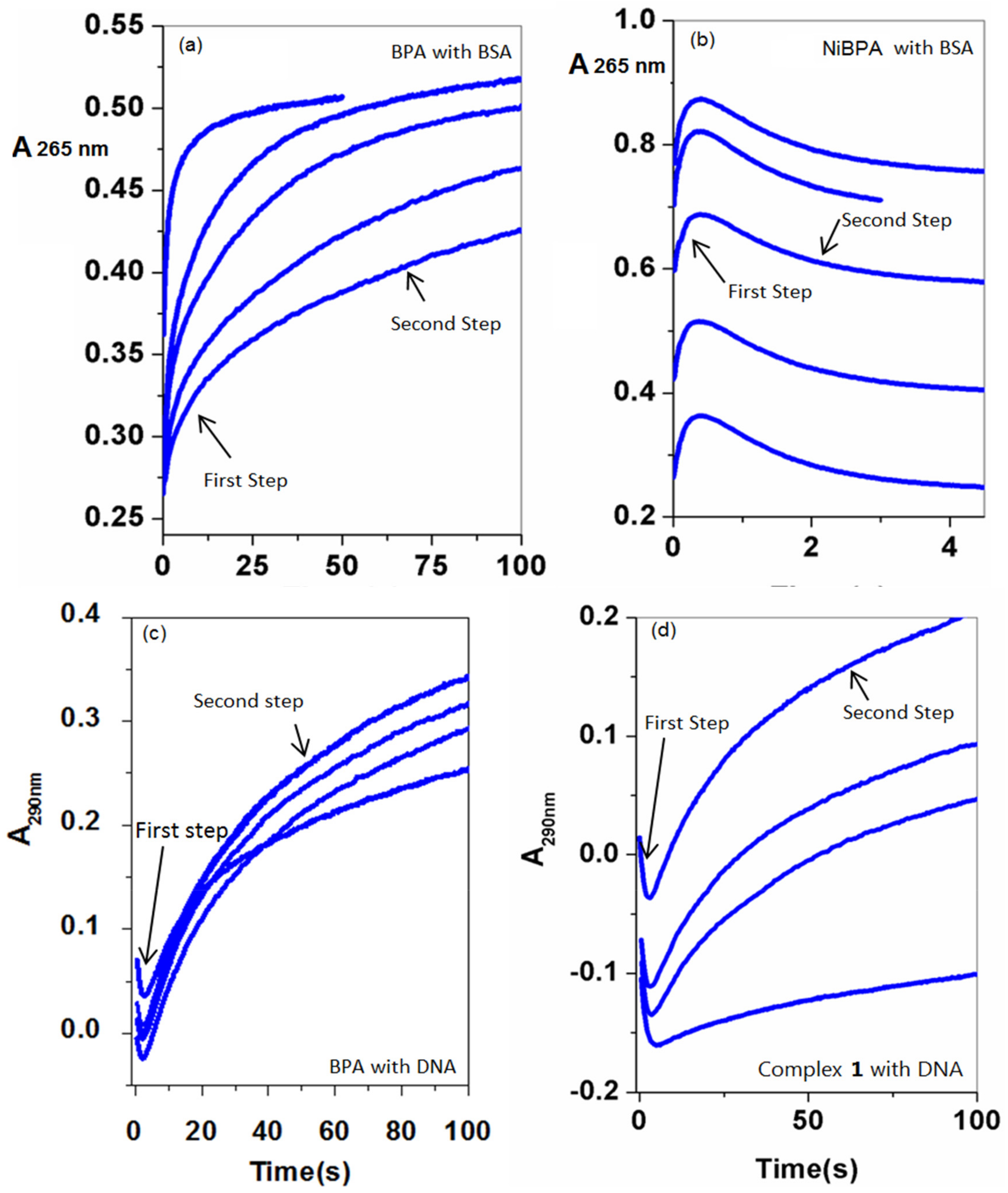
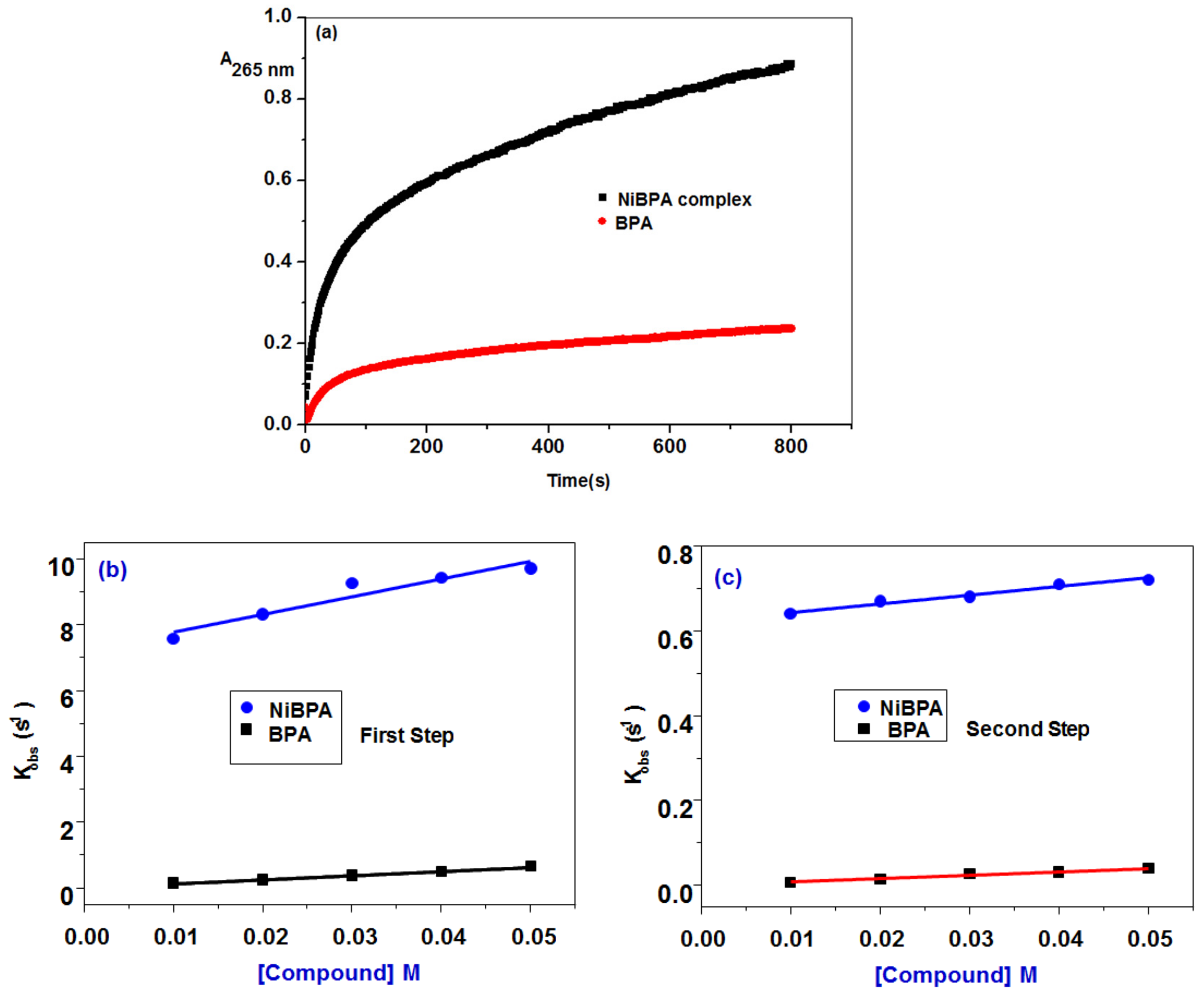



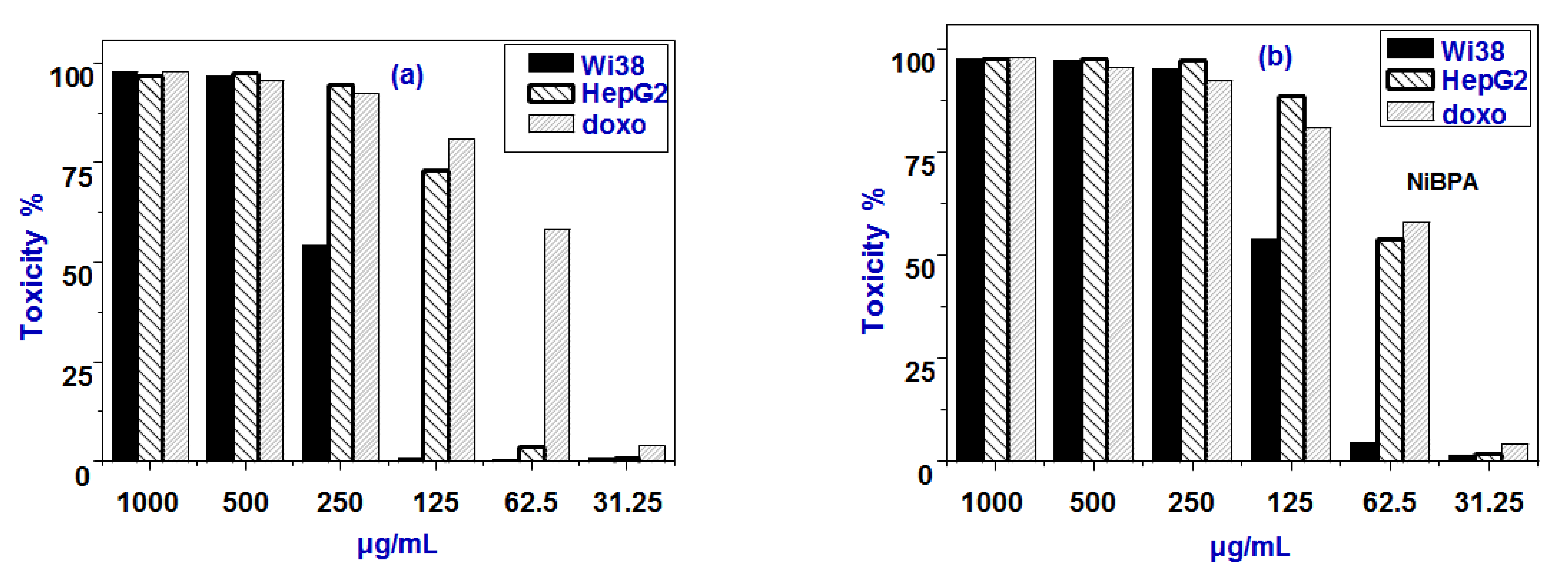

| KSV [104 M−1] | Kq[1012 M−1s−1] | n | Kbin[104 M−1] | Kb[104 M−1] | |
|---|---|---|---|---|---|
| BPA | 0.21 | 0.21 | 1.0 | 0.25 | 0.40 |
| NiBPA | 0.70 | 0.70 | 1.3 | 0.90 | 0.82 |
| BSA | DNA | ||||
|---|---|---|---|---|---|
| BPA | NiBPA | BPA | NiBPA | ||
| 1st Step | k1 [M−1s−1] | 12.5 ± 1.1 | 53.6 ± 9.0 | 27.0 ± 2.5 | 19.3 ± 2.3 |
| k−1 [s−1] | 0.17 ± 0.0 | 7.3 ± 0.3 | 0.69 ± 0.1 | 0.36 ± 0.1 | |
| Ka1 [M−1] | 73.5 | 7.3 | 40.0 | 53.6 | |
| Kd1 [10−3M] | 13.6 | 136.0 | 25.6 | 19.0 | |
| ΔG1 ≠ [kJ mol−1] | −10.6 | −5.1 | −9.1 | −9.7 | |
| 2nd Step | K2 [M−1s−1] | Irreversible step with K2 = 0.82 ± 0.08 | 2.0 ± 0.2 | 0.29 ± 0.01 | 0.23 ± 0.01 |
| k−2 [10−3s−1] | 620 ± 6 | 6.1 ± 0.3 | 5.9 ± 0.5 | ||
| Ka2 [M−1] | 3.21 | 47.5 | 39.0 | ||
| Kd2 [10−2M] | 31.2 | 2.1 | 2.6 | ||
| ΔG2 ≠ [kJmol−1] | −8.3 | −9.4 | −9.0 | ||
| Overall reaction | Kd [10−3M] | 32.3 | 52.7 | 48.2 | |
| Ka [M] | 31.0 | 1899 | 2077 | ||
| ΔG ≠ [kJmol−1] | −8.4 | −18.7 | −18.9 | ||
| Comp. | Gram-Positive Bacteria | Gram-Negative Bacteria | ||||||
|---|---|---|---|---|---|---|---|---|
| S. aureus | E. faecalis | P. aeruginosa | E. coli | |||||
| MIC | MBC | MIC | MBC | MIC | MBC | MIC | MBC | |
| BPA | 0 | 0 | 0 | 0 | 0 | 0 | 0 | 0 |
| NiBPA | 40.0 | 76.0 | 43.0 | 80.0 | 35.0 | 70.0 | 30.0 | 63.0 |
| Standard | 20.1 | 39.0 | 22.3 | 40.0 | 23.5 | 55.0 | 25.3 | 55.0 |
Publisher’s Note: MDPI stays neutral with regard to jurisdictional claims in published maps and institutional affiliations. |
© 2022 by the authors. Licensee MDPI, Basel, Switzerland. This article is an open access article distributed under the terms and conditions of the Creative Commons Attribution (CC BY) license (https://creativecommons.org/licenses/by/4.0/).
Share and Cite
Ramzy, E.; Ibrahim, M.M.; El-Mehasseb, I.M.; Ramadan, A.E.-M.M.; Elshami, F.I.; Shaban, S.Y.; van Eldik, R. Synthesis, Biophysical Interaction of DNA/BSA, Equilibrium and Stopped-Flow Kinetic Studies, and Biological Evaluation of bis(2-Picolyl)amine-Based Nickel(II) Complex. Biomimetics 2022, 7, 172. https://doi.org/10.3390/biomimetics7040172
Ramzy E, Ibrahim MM, El-Mehasseb IM, Ramadan AE-MM, Elshami FI, Shaban SY, van Eldik R. Synthesis, Biophysical Interaction of DNA/BSA, Equilibrium and Stopped-Flow Kinetic Studies, and Biological Evaluation of bis(2-Picolyl)amine-Based Nickel(II) Complex. Biomimetics. 2022; 7(4):172. https://doi.org/10.3390/biomimetics7040172
Chicago/Turabian StyleRamzy, Esraa, Mohamed M. Ibrahim, Ibrahim M. El-Mehasseb, Abd El-Motaleb M. Ramadan, Fawzia I. Elshami, Shaban Y. Shaban, and Rudi van Eldik. 2022. "Synthesis, Biophysical Interaction of DNA/BSA, Equilibrium and Stopped-Flow Kinetic Studies, and Biological Evaluation of bis(2-Picolyl)amine-Based Nickel(II) Complex" Biomimetics 7, no. 4: 172. https://doi.org/10.3390/biomimetics7040172






